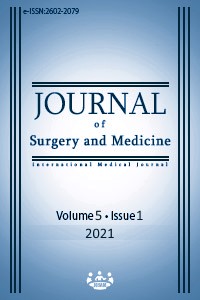The role of saline irrigation of subcutaneous tissue in preventing surgical site complications during cesarean section: A prospective randomized controlled trial
Keywords:
Cesarean section, subcutaneous tissue irrigation, surgıcal site infection, wound seperatıon, seroma, hematomaAbstract
Aim: Following cesarean section, wound complications develop in 3 to 30% of the patients. The purpose of this study is to evaluate the effect of subcutaneous saline irrigation during caesarean section on postoperative surgical site complications. Methods: This prospective randomized controlled study was conducted between November 17, 2020 and December 16, 2020 at Medipol University, Private Nisa Hospital. A total of 230 women undergoing elective cesarean delivery were divided into 2 groups. The subcutaneous tissue was irrigated with saline solution in group 1 (n=115), and not irrigated in the control group (n=115). On the 7th postoperative day, the surgical site was evaluated for hematoma, seroma, wound dehiscence, and superficial surgical site infection. Results: The incidences of seroma (7% vs. 15.7%, P=0.013), hematoma (6.1% vs. 15.7%, P=0.024) and superficial surgical site infection (4.3% vs. 11.3%, P=0.035) were significantly lower in the saline irrigation group, while the groups were similar in terms of wound dehiscence (P=0.176). Conclusion: Saline irrigation of the subcutaneous tissue during cesarean section decreased the rates of seroma, hematoma, and superficial surgical site infections significantly.
Downloads
References
O’Boyle AL, Mulla BM, Lamb SV, Greer JA, Shippey SH, Rollene NL. Urinary symptoms after bladder flap at the time of primary cesarean delivery: a randomized controlled trial (RTC). Int Urogynecology J. 2018;29:223-8. doi: 10.1007/s00192-017-3369-5.
Betrán AP, Ye J, Moller AB, Zhang J, Gülmezoglu AM, Torloni MR. The increasing trend in caesarean section rates: global, regional and national estimates: 1990-2014. PLoS One. 2016;11:e0148343. doi: 10.1371/journal.pone.0148343.
Corbacioglu Esmer A, Goksedef PC, Akca A, et al. Role of subcutaneous closure in preventing wound complications after cesarean delivery with pfannenstiel incision: a randomized clinical trial. J Obstet Gynaecol Res 2014;40:728-35. doi: 10.1111/jog.12229.
Mackeen AD, Khalifeh A, Fleisher J, et al. Suture compared with staple skin closure after cesarean delivery: a randomized controlled trial. Obstet Gynecol. 2014;123:1169-75. doi: 10.1097/AOG.0000000000000227.
Vats U, Pandit Suchitra N. Comparison of efficacy of three suture materials, i.e., Poliglecaprone 25, polyglactin 910, polyamide, as subcuticular skin stitches in post-cesarean women: a randomized clinical trial. J Obstet Gynaecol India. 2014;64:14-8. doi: 10.1007/s13224-013-0448-5.
Yildirim G, Güngördük K, Asicioğlu O, et al. Does vaginal preparation with povidone–iodine prior to caesarean delivery reduce the risk of endometritis? A randomized controlled trial. The Journal of Maternal-Fetal&Neonatal Medicine. 2012;25:2316-21. doi: 10.3109/14767058.2012.693994.
Levin D, Tulandi T. Dense adhesions between the uterus and anterior abdominal wall: a unique complication of cesarean delivery. Gynecol Surg. 2011;8:415-6. doi: 10.1007/s10397-010-0633-9.
Mueller TC, Loos M, Haller B, et al. Intra-operative wound irrigation to reduce surgical site infections after abdominal surgery: a systematic review and meta-analysis. Langenbecks Arch Surg. 2015;400:167-81. doi: 10.1007/s00423-015-1279-x.
Pieper D, Rombey T, Doerner J, et al. The role of saline irrigation prior to wound closure in the reduction of surgical site infection: protocol for a systematic review and meta-analysis. Syst Rev. 2018;7:152. doi: 10.1186/s13643-018-0813-7.
Aslan Çetin B, Aydogan Mathyk B, Barut S, et al. The impact of subcutaneous irrigation on wound complications after cesarean sections: a prospective randomised study. Eur J Obstet Gynecol Reprod Biol. 2018;227:67-70. doi: 10.1016/j.ejogrb.2018.06.006.
Pogson CJ, Adwani A, Ebbs SR. Seroma following breast cancer surgery. Eur J Surg Oncol. 2003;29:711-7. doi: 10.1016/s0748-7983(03)00096-9.
Kawakita T, Landy HJ. Surgical site infections after cesarean delivery: epidemiology, prevention and treatment. Matern Health Neonatol Perinatol. 2017;3:12. doi: 10.1186/s40748-017-0051-3.
De Jonge SW, Boldingh QJJ, Solomkin JS, et al. Systematic review and meta-analysis of randomized controlled trials evaluating prophylactic intra-operative wound irrigation for the prevention of surgical site infections. Surg Infect (Larchmt). 2017;18:508-19. doi: 10.1089/sur.2016.272.
Cervantes Sanchez CR, Gutierrez Vega R, Vazquez Carpizo JA, Clark P, Athie Gutierrez C. Syringe pressure irrigation of subdermic tissue after appendectomy to decrease the incidence of postoperative wound infection. World J Surg. 2000;24:38-41. doi: 10.1007/s002689910008.
Al-Ramahi M, Bata M, Sumreen I, Amr M. Saline irrigation and wound infection in abdominal gynecologic surgery. Int J Gynaecol Obstet. 2006;94:33-6. doi: 10.1016/j.ijgo.2006.03.030.
Gungorduk K, Asicioglu O, Celikkol O, Ark C, Tekirdag AI. Does saline irrigation reduce the wound infection in caesarean delivery? J Obstet Gynaecol. 2010;30:662-6. doi: 10.3109/01443615.2010.494206.
Downloads
- 472 648
Published
Issue
Section
How to Cite
License
Copyright (c) 2021 Derya Kanza Gül
This work is licensed under a Creative Commons Attribution-NonCommercial-NoDerivatives 4.0 International License.
















